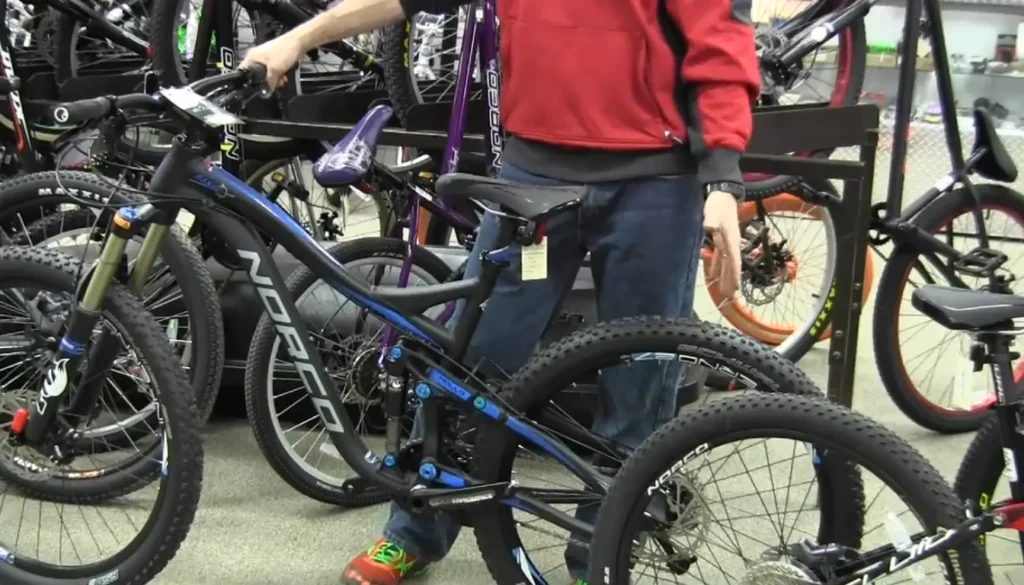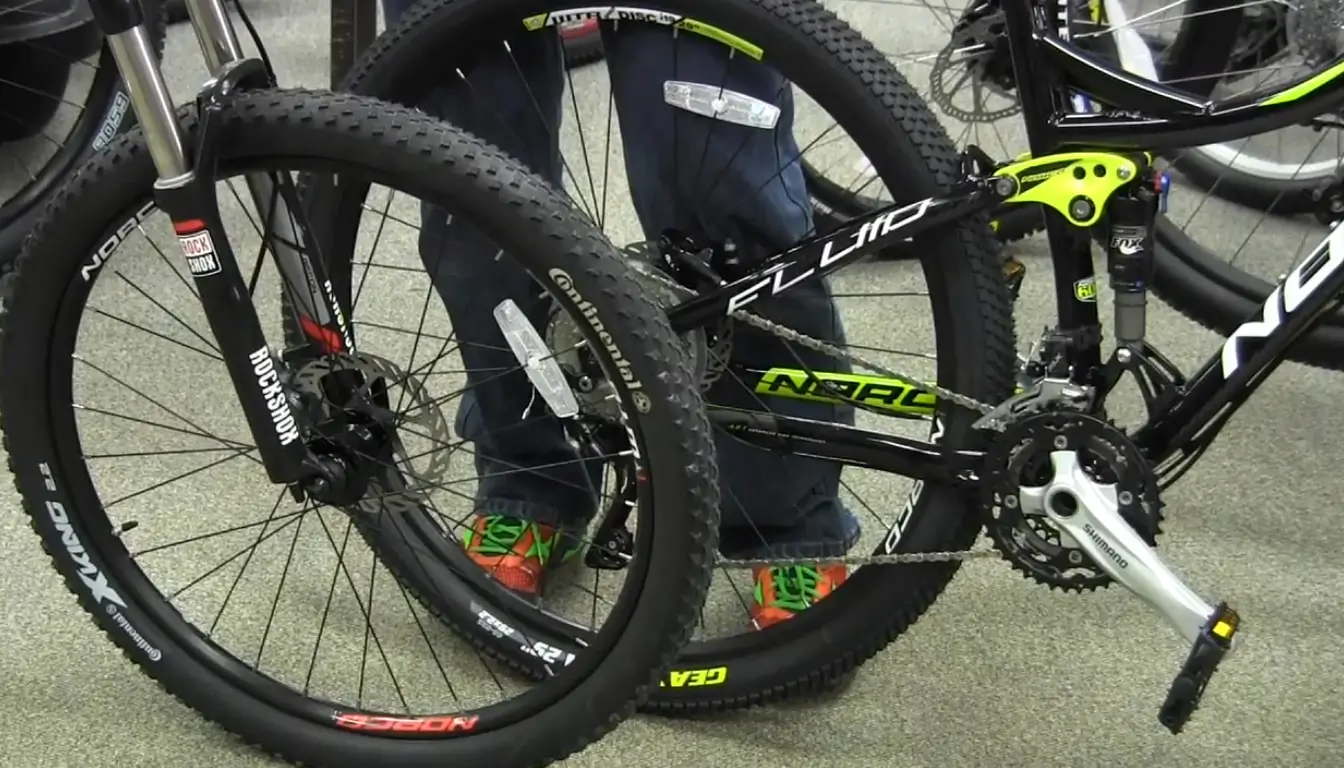We bet you can! Yes, you heard me right. You can put the 29-inch wheels on a modified full-suspension 26-inch bike frame. For that, you must be specialized and comfortable in basic bike modifications. How am I so sure? I did the research and implemented it on my 26-inch full-suspension mountain bike. During the research, I read many experts’ advice; some said it was impossible, and some said it was possible. Here, I have found the gap and tried to find a trick after carefully observing experts’ advice and then implementing the techniques with my bike. Interested in knowing more to clear this confusion and know my success recipe?
Be with me till the end, and I am sure you will be knowledgeable about this good idea and can do it yourself.
Can I replace 26 inch tires with 29 inch tires on the Bike
This tricky question has a trickier answer. As we said above, you can put 29-inch wheels on a 26-inch bike, but you need to modify your bike.
First, we must be clear about whether your bike is an MTB or a road bike. Because both bikes have differences. An MTB bike has a rigid frame; only 29-inch wheels can fit on a 29-inch frame. But if you have a road bike that too is a full-suspension one, it will allow you to put different sizes of wheels on top of it. Most of us do this to use an MTB bike on-road. We want to put skinny tires on MTB bikes to be used on flat roads at faster speeds.
Tire clearance is very important in this case, and you must have enough clearance to take care of it. Either you have to face trouble handling disc brakes with a bit bigger wheels than the 26-inch rim. You must buy an adapter for the rear wheel and use it as your front tire to make it right.
The wheel size you will get after installing 29-inch rims is 522/100-9. The 27-inch rim and spokes are closest in terms of setup to the 29-inch wheel. A bike with 522 front hub spacing can use a rigid fork with 522mm axle spacing. A single-speed bike with a 27-inch wheel provides even better handling than a pure trail hardcore bike on technical downhill routes and freshly fallen snow, with slight rim adjustment to increase the hub’s outer diameter for larger 29-inch rims.
You have to adjust the handlebars to make them consistent with the wheel size and adjust the seat tube, seat post, and the front section of the frame with a trunnion.
After adjusting the seat tube angle, you must also adjust your main chainring by putting it into different positions. This will give you a more appropriate range of motion for the rider’s neck while riding downhill or hard pedaling.
What’s the difference between 26 and 29 inch wheels

The main difference between 26-inch and 29-inch wheels on a bicycle is their size, which affects the bike’s handling, speed, and comfort.
Handling
26-inch wheels are generally more maneuverable and provide quicker acceleration due to their smaller size and lower weight, making them popular for technical off-road riding, such as mountain biking on tight trails.
Speed and Momentum
29-inch wheels, being larger, can cover more distance with each rotation and maintain momentum better. They also roll over obstacles more easily, offering a smoother ride on rough terrain, making them faster on open trails and more comfortable for long-distance rides.
Comfort
The larger diameter of 29-inch wheels provides a larger contact area with the ground, improving traction and stability and reducing the impact of bumps and obstacles, leading to a smoother ride overall.
Your choice will depend on the riding you plan to do and your personal preferences regarding handling, speed, and comfort.
Benefits Of Putting The 29 inch Wheels on a 26 Inch Bike
There are many benefits of increased wheel size. Some of the benefits include:
- Due to their larger size, it will provide more traction and grip than smaller wheel sizes.
- It will allow the riders to go faster with less effort.
- It will provide more stability while riding downhill due to its larger diameter and wider rims that offer more contact area with the ground.
- Riding over small bumps and curbs is easier, and the larger wheels make it easier to turn corners at high speeds.
- It’s also possible to use smaller gears on this switched bike because it has fewer spokes, making it faster than other types of bicycles.
But remember, if you don’t have enough knowledge in this area and the toolset, converting a 29-inch MTB bike into a 26-inch MTB bike is impossible.
Why 29 inch wheels are better than 26
29-inch wheels on a bicycle offer several advantages over 26-inch wheels, primarily in terms of momentum, obstacle clearance, and stability. The larger diameter of 29-inch wheels allows them to maintain momentum more effectively once they are up to speed, making them especially beneficial for long-distance rides and on varying terrains. These wheels have a higher attack angle, meaning they roll over obstacles like rocks and roots more smoothly, providing a less bumpy ride.
This attribute is particularly advantageous in mountain biking, where rough trails are common. Lastly, the increased wheel size contributes to a greater contact area with the ground, enhancing traction and stability, which can improve rider confidence on challenging trails. However, choosing between 29-inch and 26-inch wheels ultimately depends on personal preference, riding style, and specific cycling needs.
Why Shouldn’t You Put 29 Inch Wheels On A 26 Inch Bike?
Though you can put 29-inch wheels on a 26-inch bike, it’s not recommended. Why? Because there are huge differences between the wheel size, frame size (26er-29er), geometry, width, and weight differences, without a 29er frame, you will miss many things that can make your ride more enjoyable. Let’s know some more reasons.
- When you go for a ride with this wheels-changed bike, you will face air pressure or resistance during top-speed riding on a trek or going downhill.
- You will also face problems as the bigger wheels are heavier.
- It will cause instability, affect the tipping over & bottom bracket failure chances, Wobbling, and unsafe.
- A rider can’t ride larger wheels with smaller frames bike with comfort,
- It will also be difficult to control.
All these disadvantages compel us to forbid you from putting 29-inch wheels in a 26-inch MTB bike frame.
How to Change wheel size on a bike
Changing the wheel size on a bike involves several steps and considerations to ensure compatibility and safety. Here’s a quick guide:
Determine Compatibility: Check your bike frame and fork for the maximum wheel and tire size they can accommodate. This is crucial because a wheel that’s too large might not fit, and even if it does, it might cause the tire to rub against the frame or fork.
Choose the Right Wheel: Once you know your desired size, select a wheel that matches your bike’s specifications. Consider the wheel diameter (e.g., 26”, 27.5”, 29” for mountain bikes, or 700c for road bikes) and the axle type (quick release or thru-axle).
Consider Brake Compatibility: If your bike has rim brakes, ensure the new wheel’s rim is compatible. For disc brakes, check the disc rotor mounting system (6-bolt or center lock) and ensure the new wheel supports your bike’s brake rotor size.
Purchase a Compatible Tire: Along with the wheel, you’ll need a tire that fits the new wheel and has an appropriate width for your bike’s frame and fork.
Install the Wheel and Tire: Mount the tire on the wheel, install the inner tube (if using a tube-type tire), and then install the wheel on your bike. If you’re using disc brakes, you’ll also need to transfer the brake rotor from the old wheel to the new one (or install a new rotor if needed).
Adjust the Brakes and Gears: After installing the new wheel, you may need to adjust your brakes to ensure they properly engage the wheel. If you’ve changed the wheel size significantly, you might need to adjust your bike’s gears, especially the rear derailleur, to accommodate the new wheel diameter.
Check Clearance and Alignment: Finally, check that the wheel and tire have sufficient clearance from the frame and fork, and ensure that the wheel is properly aligned in the dropouts for smooth operation.
Changing wheel size can significantly affect your bike’s handling, performance, and geometry, so it’s important to consider these changes carefully. Consulting with a professional bike mechanic is highly recommended if you’re unsure about any steps or compatibility issues.
Can You Switch Back To A 26 Inch Mountain Bike from 29 inch Wheels?
Yes, you can switch back to a 26-inch mountain bike from 29-inch wheels whenever you need. Usually, no rider wants to return to 26-inch wheels after replacing them with 29-inch wheels. No rider would love to leave these facilities and return to their old MTB bike because it offers smoother ride-on bumps, better handling and controls, top speed, and many more.
But if you want, it’s possible to switch back to a 26-inch mountain bike with 29-inch wheels. Smaller wheels can perfectly fit on a larger frame. So, keeping taller riders’ benefits in mind, many manufacturers have already manufactured 26-inch plus wheels, and many bike shops are selling them with good reviews. These are designed for each bike fit, especially in larger frames, so mountain bikers feel this is the best way to transform their bike according to their needs.
But why would someone leave a better experience? No one, yes, no one will do such a thing until he needs it. Exchanging 29 er rear tires and returning to a 26 er only happens when someone shorter or a short rider will ride it. If you think a 29er bike is larger for you or someone you want to gift, you can do this. Another reason can be riding it only over the tough trail for better steering power, I mean only for mountain biking.
FAQs For Put 29 Inch Wheels On A 26 Inch Bike
Can I Change The Wheel Size On My Bike?
Yes, you can. The wheels are not attached to the bike’s frame, and a new set of wheels can replace them with different dimensions. But changing the wheel size on a bike will be difficult. You have to buy an adapter to change the front wheel with a smaller one and more modifications like adding a lower front fork.
Are 26 Inch Wheels Too Small?
26 inch wheels are not too small, but they are too small for some people. A 26-inch wheel is a good size for smaller frames and people who like to ride on a bike as it gives you more maneuverability in tight spaces.
Is a 26 Inch Wheel Bike For Adults?
It depends on what you need from your bike. 26-inch wheel bikes are ideal for people who want to travel fast and have a more maneuverable ride than the standard 27-inch wheel bikes. BMX and mountain bikers also use the 26-inch wheel size because it allows them to quickly change direction or stop in their tracks without going through the pain of slowing down.
What Is The Weight Limit For a 26 Inch Bike?
A 26-inch bike is considered a mountain bike, with a weight limit of up to 100 pounds. A mountain bike has an extra-large frame and wide tires for a stable ride over rugged terrain.
How Much Bigger Are 27.5 Wheels Than 26?
The size of the wheel is measured in millimeters. 26-inch wheels are 622mm in diameter, 27.5-inch wheels are 688mm in diameter, and 29-inch wheels are 735mm in diameter.
Can A 6 Foot Man Ride A 26 Inch Bike?
The general rule of thumb is that a bike with a wheel size smaller than the rider’s height will be too small for him. However, if you are looking to get on a 26-inch bike, it can accommodate someone 6 feet tall.
Can I Run 27.5 Wheels On My 26?
Yes, you can run a 27.5 wheel on your 26 bikes using a wider hub and tire designed for the larger diameter. These wheels will reduce rolling resistance and give you more traction and control over the terrain.
Can I Ride a 26 Inch Bike?
It is always a good idea to measure the height of your bike before you buy it. A 26-inch bike will fit those who are 4 feet 8 inches or shorter in height. So if you are under this height, you can definitely ride a 26-inch bike.
How Tall Should You Be For A 27 Inch Bike?
For a 27 inch bike, the maximum recommended height is 5’10” or taller. This may vary depending on your weight and riding style. However, shorter riders can still use 27-inch bikes as long as they are confident in their riding skills and have adequate clearance to avoid pedal strikes.
Are 27.5 Wheels Better Than 26?
No, 27.5 wheels are not better than 26 wheels. The larger diameter of the wheel makes it harder to fit inside the tire, which increases rolling resistance.
Which Mountain Bike Wheel Size is Best?
26″ is the best wheel size for a mountain bike because it provides the most traction, ideal balance of speed, and control. They are lightweight and less expensive than larger diameters, perfect for commuting or recreational riding on moderate terrain. However, if you are looking for speed, going to24″ wheels would be better. These smaller diameter bikes allow for more stability and responsiveness due to their higher weight per inch ratio than 26-inch wheeled bicycles.
It’s possible to convert a 26-inch bike into a 29-inch MTB bike, but it’s inappropriate. Most experts recommend buying a mountain bike with a frame designed to fit the wheel size, not a larger wheel on a smaller bike. But as we outlined, you can do it to enjoy some 29er mtb bike advantages without having a 29-inch wheel mtb bike. Like advantages, you will also face some disadvantages (lower performance in crowded commute riding, inability to handle bumpy trails, lower speed on rugged trails, etc. If you want a bike for balance benefits, you can try the new 27.5-inch hardtail MTB bike of Kona or Santa Cruz; they manufacture affordable bikes for MTB biking and road biking.

I am Ryan Ford, a mountain biking enthusiast who loves to explore the outdoors. I also like to go on adventures with friends and anything else that involves being outside. I love my bike because it gets me out of the house and gives me an opportunity to enjoy nature.

